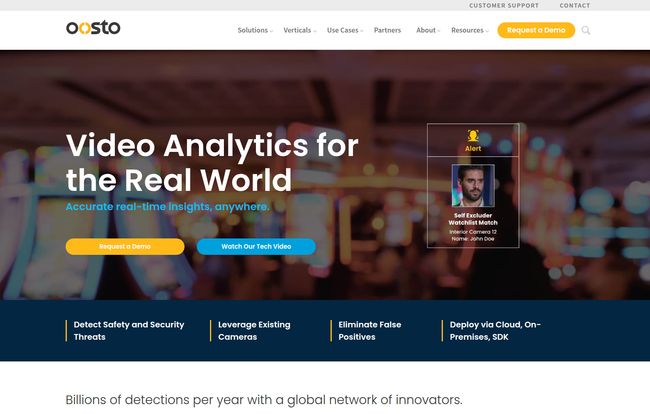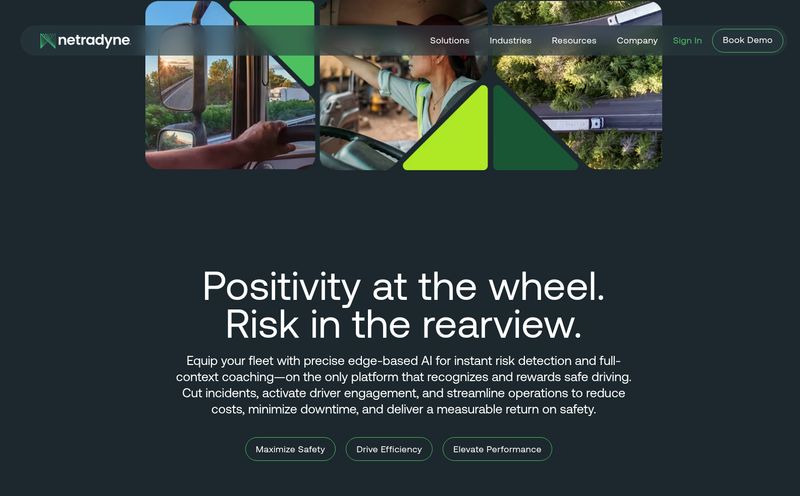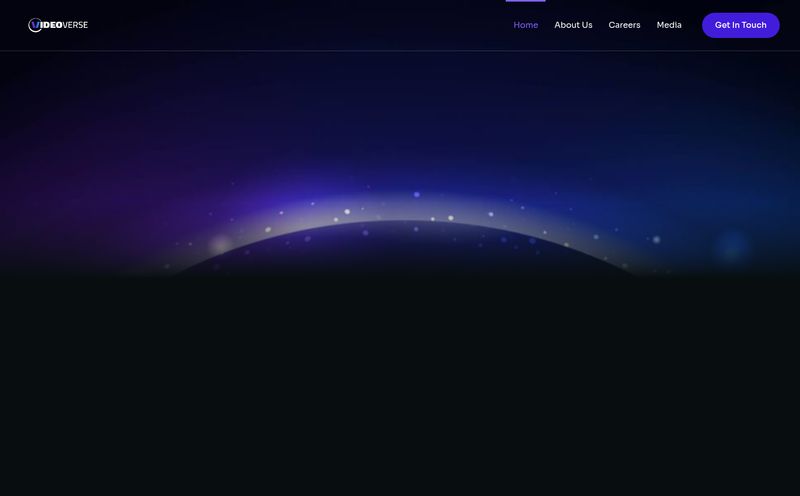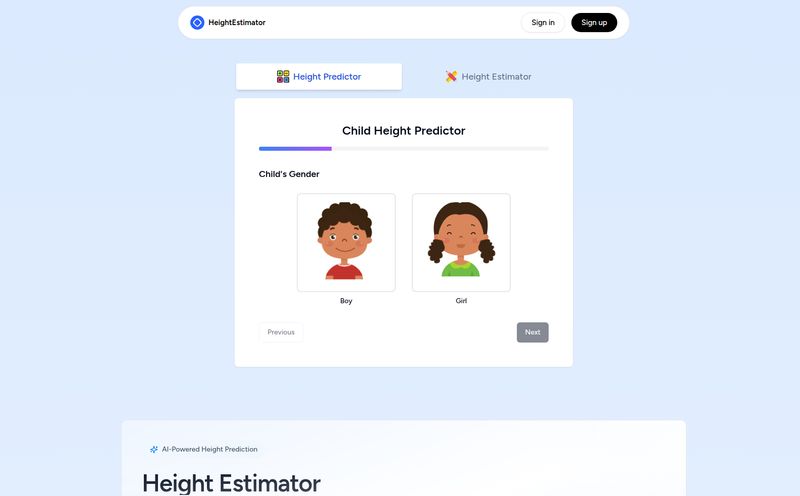I’ve been in the SEO and digital trends game for a long time. Long enough to remember when just getting a website to rank felt like magic. Now, we're talking about AI that can write, create art, and drive cars. It’s wild. And that same leap is happening in the world of security. Remember squinting at a grainy CCTV monitor, trying to figure out if that blurry blob was a person or a particularly large raccoon? Those days are, for some, officially over.
That brings me to companies like Oosto. I stumbled upon their platform recently, and my inner data-nerd lit up. They're not just selling cameras; they're selling a brain for your cameras. They call it "Video Analytics for the Real World," and frankly, that got my attention. It’s a bold claim. So, I decided to do what I do best: take a deep, no-nonsense look at what they're offering, who it’s for, and whether it lives up to the hype. Let's get into it.
So What Exactly is Oosto Anyway?
At its heart, Oosto provides real-time facial recognition and video analysis for security purposes. But calling it just facial recognition feels a bit like calling a smartphone just a telephone. It misses the point. Oosto’s platform is built on what they call Vision AI, which is a much bigger bucket.
Think of it like this. Old security systems could record what happened. Oosto aims to understand what’s happening, as it happens. It's designed to recognize people of interest from a watchlist (their On-Watch feature), but it also analyzes body movement and behavior. It can tell the difference between a person running for a bus and a person running in a panic. It can grant touchless access to a building for authorized staff (their On-Access feature) or flag unusual activity in a restricted area. It's proactive, not just reactive.
They’ve engineered this to work with the camera systems you probably already have, which is a huge plus. And it can be deployed on your own servers, in the cloud, or on an edge device. That kind of flexibility is pretty rare and shows they understand that a one-size-fits-all approach is a recipe for disaster in the security world.

Visit Oosto
The Good Stuff Oosto Brings to the Table
Alright, let's talk about the wins. The biggest promise Oosto makes is the reduction of false positives. Anyone who's worked with any kind of alert system—be it for website downtime, lead notifications, or security—knows the pain of false alarms. It’s the digital equivalent of 'The Boy Who Cried Wolf.' After a while, you just start ignoring the alerts, which completely defeats the purpose. Oosto's focus on accuracy, using advanced AI to distinguish real threats from everyday noise, is probably its most compelling feature. Lee-Ann T. from F5 Networks was quoted on their site saying the system is "highly intuitive and remarkably user-friendly," which is a strong endorsement from a major tech player.
The deployment options are also a standout. For a global corporation with strict data laws, keeping everything on-premises might be non-negotiable. For a smaller, more agile company, a cloud-based solution is a no-brainer. Offering both, plus SDK access for custom jobs, is smart. It’s like giving customers the choice between a tailor-made suit, a top-of-the-line rental, or the fabric and pattern to make their own. It respects that different organizations have different needs, budgets, and technical chops.
Let's Talk About the Elephant in the Room
You can't talk about a tool like this without addressing the obvious. The moment you say "facial recognition," alarm bells start ringing for a lot of people, and for good reason. It's powerful technology, and with great power... well, you know the rest. So, let’s tackle the concerns head-on.
The Ethics and Privacy Question
I was genuinely pleased to see Oosto dedicate significant real estate on their website to their commitment to ethical AI. They talk about protecting privacy, mitigating bias, and securing data. This isn't just marketing fluff; it's a necessary response to a very real public conversation. We've all seen headlines about biased algorithms that are less accurate for certain demographics. A security system that can’t identify everyone equally isn’t just ineffective, it’s dangerous. Oosto claims its tech has the "highest accuracy for dark-skinned females," citing a study from NIST (the National Institute of Standards and Technology). That’s a specific, bold claim and one that shows they’re at least confronting the problem directly.
However, a company's promise is only as good as its implementation. The responsibility ultimately falls on the organizations that buy and use this technology to do so ethically and transparently. It’s a tool, and like any tool, it can be misused.
Practical Hurdles to Consider
Beyond the big ethical questions, there are some real-world limitations. Oosto’s AI is smart, but it’s not magic. Its accuracy is fundamentally tied to the quality of the cameras it’s connected to. The old saying “garbage in, garbage out” is truer here than anywhere else. If your cameras are low-resolution, poorly lit, or placed at weird angles, you can't expect miracles. So, while you might not need to replace your entire camera network, you might need some strategic upgrades.
Then there's the cost. As you'll see in a bit, Oosto doesn't list their prices. That’s usually a sign that we’re talking about enterprise-grade software with a price tag to match. This isn’t going to be a solution for a small retail shop or a local community center. This is for organizations with mission-critical security needs and the budget to support them.
Who is This For, Realistically?
So, where does Oosto fit? Their site gives us a pretty clear picture. We're talking about large-scale operations. Think about a sprawling casino. Security needs to discreetly identify high-rollers for VIP treatment and, at the same time, spot individuals on a self-exclusion list or known cheaters. Oosto’s tech could do that in real-time, sending a quiet alert to the floor manager’s tablet.
Or picture a major airport or stadium. The ability to scan thousands of people an hour, identify a person of interest from a security watchlist, and track their general location without disrupting the flow of the crowd is a game-changer for public safety. It moves security from a defensive posture to a proactive one. Other use cases they highlight include corporate buildings for frictionless employee access, schools for campus safety, and even retail for loss prevention.
The All-Important Question of Oosto Pricing
I know what you're thinking. "Just tell me how much it costs!" I wish I could. But like many B2B platforms providing complex, scalable solutions, Oosto does not have a public pricing page. This is typical for the industry.
Why? Because the cost depends entirely on the scale of your operation. How many cameras do you have? How many locations? Do you need a cloud or on-premise solution? How many people will need access? It's a custom setup, so you get a custom quote. You’ll have to contact their sales team and get a demo to find out what an investment in Oosto would look like for your specific organization. Don't expect a simple three-tiered pricing plan here.
My Final Take as an SEO Guy
Here’s my two cents. At the end of the day, my job is about pattern recognition and data analysis to predict and influence behavior (clicks, traffic, conversions). In a weird way, Oosto is doing teh same thing, just in the physical world. Instead of keywords, they're analyzing pixels. Instead of SERP rankings, they're analyzing security threats.
The technology is undeniably powerful. The focus on integrating with existing hardware and offering flexible deployment shows a deep understanding of their market. But the success of a tool like this hinges on responsible use. The ethical guardrails they claim to have built in are a great start, but the real test is how they're applied in the field. It's a powerful solution for a very specific set of high-stakes problems. It's not a magic wand, but for the right organization, it could be an incredibly effective shield.
Frequently Asked Questions about Oosto
- 1. What is Oosto used for?
- Oosto is primarily used for advanced security and safety. Its main applications include real-time person of interest alerting, touchless access control for buildings, and forensic video analysis to investigate incidents after they occur.
- 2. Can Oosto use my existing security cameras?
- Yes, one of Oosto's main advantages is its ability to integrate with most existing IP camera systems and Video Management Systems (VMS). This significantly reduces the initial hardware cost and complexity of deployment.
- 3. Is Oosto just another facial recognition company?
- Not exactly. While facial recognition is a core component, Oosto's platform is a broader Vision AI technology. This means it also analyzes body movement and behavior to provide more context and reduce false alarms, making it more of a comprehensive video analytics solution.
- 4. How does Oosto address privacy concerns?
- Oosto states a commitment to ethical AI. They offer features designed to protect privacy, such as data encryption and controls to prevent unauthorized access. They also focus on mitigating and monitoring for algorithmic bias to ensure fairness and accuracy across different demographics.
- 5. How much does Oosto cost?
- Oosto does not publish its pricing publicly. As an enterprise-level solution, pricing is customized based on factors like the number of cameras, deployment type (cloud vs. on-premise), and the specific features required. You must contact their sales team for a custom quote.
- 6. What industries benefit most from Oosto?
- Oosto is best suited for large-scale environments with high-stakes security needs. This includes public safety (airports, smart cities), large corporations, casinos and gaming, stadiums and event venues, and educational campuses.
Conclusion
So, is Oosto the future of security? The technology itself is certainly pointing in that direction. The shift from passive recording to active, intelligent analysis is a major one. Oosto has built a powerful, flexible, and seemingly thoughtful platform to lead that charge. But it comes with a heavy dose of responsibility. For organizations that understand the stakes and are committed to ethical implementation, it represents a profound new capability. It’s not science fiction anymore; it’s just a matter of deciding how we want to use it.



